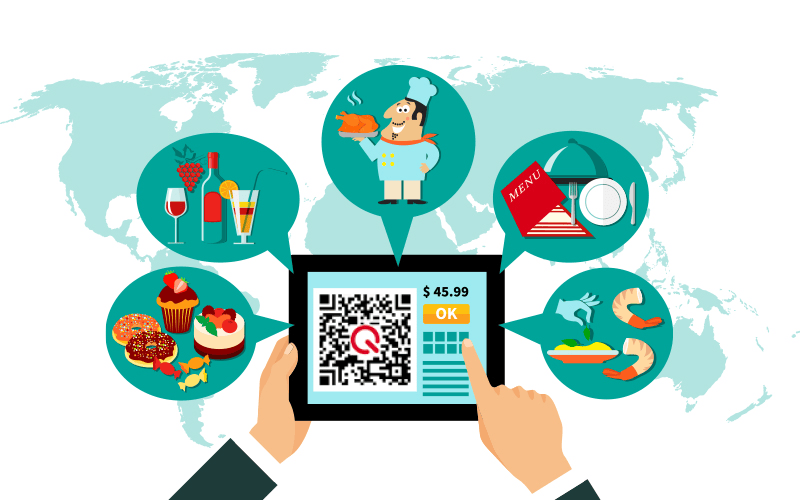
QR Codes for Food Delivery and Restaurant Menus
The rise of QR codes in the food service industry has transformed how customers interact with restaurants. From digital menus to contactless ordering and payments, QR codes offer convenience, efficiency, and a streamlined dining experience. Let’s dive into their benefits, implementation, and future impact.
Key Takeaways
- Convenience: QR codes provide quick access to menus and enable direct ordering.
- Cost Efficiency: Digital menus reduce printing costs and allow real-time updates.
- Enhanced Customer Experience: QR codes improve hygiene, streamline service, and provide valuable data for personalization.
- Revenue Growth: Restaurants using QR codes see improved order values and operational efficiency.
What are QR Codes and How They’re Used in Restaurants
What are QR Codes?
QR (Quick Response) codes are scannable barcodes that store data such as website URLs or menu links. Customers access this information by scanning the code with a smartphone.
How Restaurants Use QR Codes
- Digital Menus: Replace physical menus with QR codes placed on tables or counters.
- Ordering Systems: Customers scan the code to browse, select, and order food directly.
- Payment Solutions: QR codes allow for secure, contactless payments.
Benefits for Food Delivery
- Streamlined Ordering: QR codes simplify online orders by directly linking to menu options.
- Improved Efficiency: Orders are automatically processed through integrated POS systems.
- Data Insights: QR codes collect customer data, enabling better targeting and menu optimization.
Creating and Using QR Codes in Restaurants
How to Create QR Codes for Menus
- Choose a QR Code Generator: Select a reliable platform like Menu Tiger or QRStuff.
- Upload Menu Information: Convert your menu into a digital format (PDF or webpage).
- Design the QR Code: Customize the code with logos, colors, and shapes for branding.
- Test the Code: Ensure it works seamlessly on multiple devices.
- Display Strategically: Place QR codes on tables, counters, signage, or napkins.
Top QR Code Generators for Restaurants
| QR Code GeneratorKey FeaturesProsCons | |||
| Menu Tiger | Dynamic QR codes, POS integration | Easy customization, real-time updates | Pricing can be high |
| QR Code Monkey | Unlimited free static codes | User-friendly, detailed analytics | Dynamic codes require payment |
| QRStuff | Wide range of applications | High level of customization | Limited free options |
Crafting Effective Menu Descriptions for QR Code Menus
Tips for Writing Enticing Descriptions
- Be Concise: Short, clear descriptions are easier to read.
- Use Sensory Language: Highlight taste, texture, and aroma to entice customers.
- Emphasize Ingredients: Cater to dietary preferences by listing key ingredients.
- Tell a Story: Connect dishes to your restaurant’s unique identity or cultural influences.
Creative Ways to Display QR Codes
Innovative Display Methods
- Table Tents: Compact and easy to place on dining tables.
- Posters and Signs: Grab attention at entrances or waiting areas.
- Window Decals: Allow passersby to view the menu before entering.
- Interactive Screens: Use digital kiosks with QR code scanning functionality.
- Server Aprons: Display QR codes on staff uniforms for a playful twist.
Best Practices
- Clear Placement: Ensure QR codes are visible and easy to access.
- Instructions Included: Add simple directions for scanning.
- Engaging Design: Incorporate your brand’s aesthetic to attract attention.
Future Outlook for QR Codes in the Food Industry
Why QR Codes Are Here to Stay
- Increased Adoption: As customers become more tech-savvy, QR code usage continues to rise.
- Sustainability: Digital menus reduce paper waste, aligning with eco-friendly practices.
- Versatility: Beyond menus, QR codes can manage reservations, loyalty programs, and feedback collection.
- Enhanced Data Analytics: Restaurants can use QR code data to refine marketing and improve operations.
Conclusion
QR codes have reshaped the food industry, offering benefits that range from cost savings to improved customer experiences. Whether for in-restaurant dining or food delivery, this technology provides a powerful tool for streamlining operations and staying ahead in a competitive market.